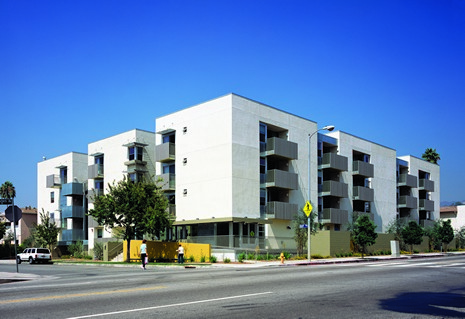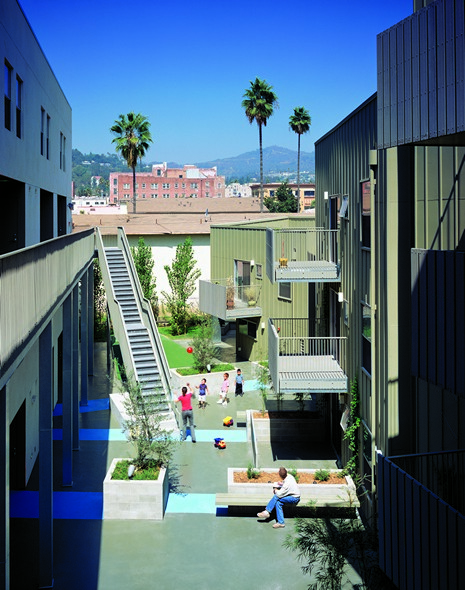Description
This project description is an excerpt from the longer article “Urban Block Shapers”. For a comparative analysis and further data including accompanying graphs, please see the article “A Turning Point”.
Moving away from the European context where urban block shapers commonly occur, instances of this approach towards housing and urban design can also be found in North America albeit in the form of individual row houses that collectively line the edges of blocks in cities like New York City, Boston, and San Francisco. A notable project that is inserted into a subdivided block, giving shape to both the block as well as its own lot, is the Harold Way Apartments in Hollywood, California, completed in 2003. Designed by Koning Eizenberg Architecture for the Hollywood Community Housing Corporation, this affordable housing project sits on the corner of a block, occupying a site area of 0.24 hectares. Given the demand for economy due to the limited funding, as well as other code requirements such as the allocation of 25 percent open space area and setbacks, the architects achieved their desired density by fitting in 51 units within a configuration of two parallel bars sandwiching a thin zigzag building in the center. The longer edges of the four-storey-tall parallel bars define both the major artery of North Western Avenue and the boundary with the adjacent lot, while the shorter edges facing Harold Way reveal the tripartite arrangement interspersed with two pedestrian courtyards. While the two parallel stucco-clad bars frame the site, the central block clad in cement board and wood battens steps down in elevation towards the back, opening up views to Hollywood Hills to the north.
The unusual composition of this central zigzag building not only injects some rhythm and sequence to the project from the interior, defining the outdoor external access balconies with bridges linking the residents directly to the paired entrances of their apartments, it also carves out the big courtyard for the children’s play area and the barbecue hubs for the community, thereby activating the site and lending an urban feel to the project. Together with the landscaping at the end of the vista, as well as other amenities like the provision of a community room and a laundry area, the architects pay much attention to these “little things” that help to “make life sweeter”.
1
Julie Eizenberg, Architecture Isn’t Just for Special Occasions: Koning Eizenberg Architecture (New York, NY: Monacelli Press, 2006), 139.
Each building is no more than 10 meters deep, creating this courtyard space where all apartments receive adequate light and cross-ventilation, effectively eliminating the need for air-conditioning. In total, the scheme offers a variety of unit types, including 17 one-bedroom units, 19 two-bedroom units, and 15 three-bedroom maisonettes.
Footnotes
Julie Eizenberg, Architecture Isn’t Just for Special Occasions: Koning Eizenberg Architecture (New York, NY: Monacelli Press, 2006), 139.
Drawings
Axonometric site plan of building complex and its surroundings
Sectional perspective view of building complex within its specific urban context
Site plan, scale 1:10000
Site plan illustrating the building’s contextual connectivity
Standard floor, scale 1:1000
Cross section with usage distribution, scale 1:1000
Residential unit types and distribution, scale 1:500
Photos

Exterior street view

Exterior courtyard view
Originally published in: Peter G. Rowe, Har Ye Kan, Urban Intensities: Contemporary Housing Types and Territories, Birkhäuser, 2014.